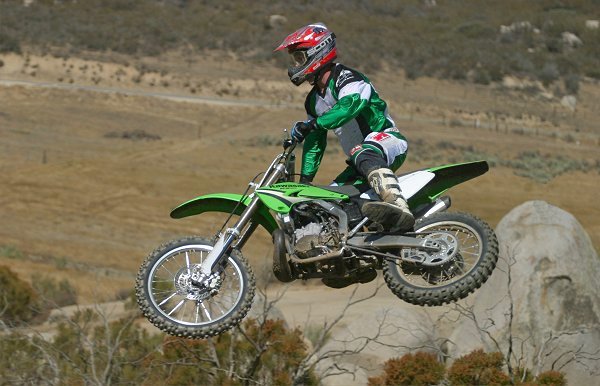
Although MD may be as guilty as anyone in prematurely announcing the death of the two-stroke motocross bike, this year we have seen one of the largest investments ever made by major manufacturers in new two-stroke machinery. The subject of this ride review is a perfect example. James “Bubba” Stewart will stay at Kawasaki next year, and race this all-new 2005 KX250 in the AMA Supercross series.
Kawasaki’s investment in this new machine, which includes a virtually new engine, frame and front suspension system, is discussed to some extent in our article dated June 18, 2004. Take a look there for some of the technical details.
Kawasaki invited us out to Cahuilla Creek Motocross Park to ride the new KX250, and we gave that “chore” to Russ Sommers, a Southern California pro who has tested for us many times before, and is known for his objectivity and ability to decipher the performance issues presented by each new model.
For context, Russ has ridden virtually every competitor’s machine, including the 2005 Suzuki RM250, and is the owner of a 2004 Yamaha YZ250 (the new, aluminum-framed YZ250 carries over the 2004 engine with virtually no changes).
In a nutshell, Russ was extremely impressed with the motor on the 2005 KX250. At close to 4,000 feet in altitude, bikes tend to feel a little soft at Cahuilla Creek. The KX250 felt anything but soft. The pull from right above idle is perhaps the strongest we have yet experienced from a 250cc two-stroke motocross bike. Stronger at the bottom than either the YZ250 or the RM250, the Kawasaki continues to pull strongly and smoothly into a very powerful mid-range before signing off with a decent, but not spectacular top end. Overall, Russ said the motor rates an “A” in the low-end, an “A” in the mid-range, and a “B” on the top-end.
We did make one jetting change from stock. We dropped the needle one notch, in order to lean out the carburetion. This made the bike much snappier off the bottom, and cleaner throughout the power band. We understand this jetting change works pretty well at sea level, also.

The new KX250 features a new frame that is narrower at the foot pegs, with a steeper steering head angle (see our earlier article). The handling of the bike was very difficult to fault. Despite weighing close to 230 pounds (well beyond the target weight of the stock spring rates on the shock and the fork), the 6′ 3″Russ was able to dial the suspension to work to his liking (setting the sag on the shock at 100mm, and adding compression to both the shock and the fork). Stiffer fork springs clearly would have been ideal for someone of Russ’ weight, but it was clear that the KX250 has much improved suspension this year.
The entirely new fork (which mimics, to some extent, the Showa twin chamber design) from KYB feels very smooth and linear. Absorbing small chop, while resisting bottoming reasonably well. A good job of valving by the factory that we would really like to test with stiffer springs.
The new chassis, with its steeper steering rake, really carves corners. Russ noted, particularly, the ability of the KX250 to catch ruts in the corners, and hold its line. Russ was almost able to drag the bars in some of the Cahuilla Creek corners (even those with small berms). He really liked the KX’s handling, including both its turning ability and its straight line stability.
The ergonomics work pretty well for Russ. The taller seat, coupled with the narrower, roomier chassis layout, lent itself well to the big man.
Russ did have an occasional problem shifting under full throttle up one of the whooped-out Cahuilla Creek hills, but didn’t complain too much about the Kawasaki’s transmission performance. Gear ratios were fine, as you would expect on a machine putting out this kind of low-end power and torque. Second-gear corners could be railed in third, without the motor falling below the power band.
Overall, our brief encounter with the 2005 KX250 was a very positive one, and bodes well for Stewart’s performance in 2005. 2005 KX250s are available at U.S. dealerships at an MSRP of $5,999. Take a look at Kawasaki’s web site for additional details.






